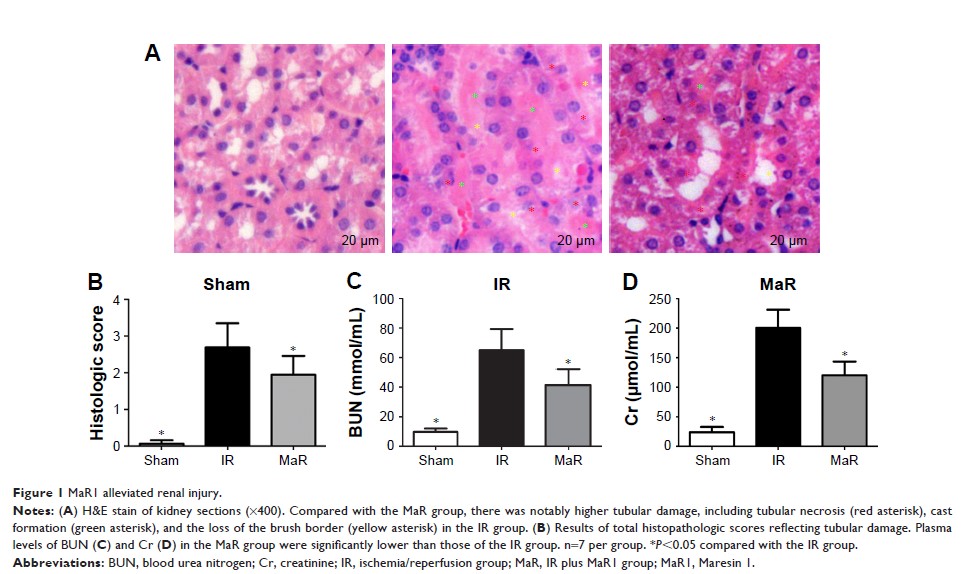108605
论文已发表
注册即可获取德孚的最新动态
IF 收录期刊
- 3.4 Breast Cancer (Dove Med Press)
- 3.2 Clin Epidemiol
- 2.6 Cancer Manag Res
- 2.9 Infect Drug Resist
- 3.7 Clin Interv Aging
- 5.1 Drug Des Dev Ther
- 3.1 Int J Chronic Obstr
- 6.6 Int J Nanomed
- 2.6 Int J Women's Health
- 2.9 Neuropsych Dis Treat
- 2.8 OncoTargets Ther
- 2.0 Patient Prefer Adher
- 2.2 Ther Clin Risk Manag
- 2.5 J Pain Res
- 3.0 Diabet Metab Synd Ob
- 3.2 Psychol Res Behav Ma
- 3.4 Nat Sci Sleep
- 1.8 Pharmgenomics Pers Med
- 2.0 Risk Manag Healthc Policy
- 4.1 J Inflamm Res
- 2.0 Int J Gen Med
- 3.4 J Hepatocell Carcinoma
- 3.0 J Asthma Allergy
- 2.2 Clin Cosmet Investig Dermatol
- 2.4 J Multidiscip Healthc

Maresin 1 通过抑制 TLR4/MAPK/NF-κB 通路和激活 Nrf2 通路减轻小鼠肾缺血/再灌注损伤
Authors Qiu Y, Wu Y, Zhao H, Sun H, Gao S
Received 25 September 2018
Accepted for publication 29 January 2019
Published 20 February 2019 Volume 2019:13 Pages 739—745
DOI https://doi.org/10.2147/DDDT.S188654
Checked for plagiarism Yes
Review by Single-blind
Peer reviewers approved by Dr Colin Mak
Peer reviewer comments 1
Editor who approved publication: Dr Sukesh Voruganti
Background: Inflammation
and oxidative stress play a crucial role in the pathogenesis of renal
ischemia/reperfusion injury (IRI). Maresin 1 (MaR1), which has shown strong
anti-inflammatory and antioxidant effects, was recently reported to have
protective properties in several different animal models.
Aim: The
objectives of our study were to determine whether MaR1 alleviates renal IRI and
to identify the underlying mechanisms.
Materials and methods: The mouse
model in this study was induced by ischemia of the left kidney for 45 minutes
and by nephrectomy of the right kidney. All mice were intravenously injected
with a vehicle or MaR1. Renal histopathologic changes, function,
proinflammatory cytokines, and oxidative stress were assessed. The expression
of proteins was measured by Western blot.
Results: The
results indicated that MaR1 markedly protected against renal IRI. The
protective effects were accompanied by the reduction of histologic changes and
reduction of renal dysfunction. Meanwhile, MaR1 remarkably mitigated renal
IRI-induced inflammation and oxidative stress. In addition, our results showed
that MaR1 significantly inhibited the expression of TLR4 and the expression of
phosphorylated Erk, JNK, and P38. Furthermore, MaR1 decreased the nuclear
translocation of NF-κB and increased the nuclear translocation of Nrf2.
Conclusion: MaR1
protects against renal IRI by inhibiting the TLR4/MAPK/NF-κB pathways, which
mediate anti-inflammation, and by activating the Nrf2 pathway, which mediates
antioxidation.
Keywords: renal
ischemia/reperfusion injury, Maresin 1, TLR4, MAPK, NF-κB, Nrf2
